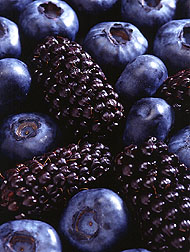Bigger, Better Berries Available Soon
|
|
Fruit salads, ice cream, and pastries may soon be bursting with new berry varieties from the Agricultural Research Service.
Five just-released cultivars of blackberries, blueberries, and strawberries promise to delight not only consumers, but growers ranging from home gardeners to commercial producers.
"In general, these berries ripen before or after the typical growing season, making fresh fruit available longer each summer," says geneticist Chad E. Finn. Finn developed and released the berries with cooperation from other ARS scientists and Oregon State University. He works at the ARS Horticultural Crops Research Laboratory in Corvallis.
Another advantage, says Finn, is that many of the new cultivars produce much larger fruit than their existing commercial counterparts.
The two new blackberries are prime examples. Black Butte berries are among the world's largest. Averaging 2 inches long and 1 inch in diameter, they are almost twice the size of most fresh blackberries. Siskiyou is also large and especially sweet. This berry starts ripening a couple of weeks ahead of the main berry season, to hit the fresh market early; later fruit from the same vines can go into yogurt, ice cream, and bakery products.
"Both of these large blackberries are quite attractive to pick-your-own operators and large commercial growers," says Charlie Boyd, who propagates the berry plants at Cedar Valley Nursery in Centralia, Washington. "Siskiyou has established a niche market and commands a premium price."
Chandler, a high-yielding highbush blueberry, also bears very large fruit. This late midseason berry comes in after the industry standard, Bluecrop. While most blueberries ripen over a 3-week period, Chandler provides ripe fruit for 4 to 5 weeks.
Chandler was initially selected and developed by Arlen Draper at the ARS Fruit Laboratory in Beltsville, Maryland. Mark K. Ehlenfeldt, a geneticist at the ARS Blueberry/Cranberry Research Laboratory in Chatsworth, New Jersey, completed its development and cooperative release with ARS in Oregon.
Two new strawberries, Firecracker and Independence, also produce berries longer. "These strawberries begin ripening around the 4th of July and extend the season up to 3 weeks," says Finn. A less obvious benefit to the extended season, he says, is that growers can keep their field workers employed longer.
An order to your favorite berry nursery this winter should ensure the new varieties arrive for spring planting. Growth and ripening will vary, of course, depending on location and conditions.
Whether you grow these berries yourself or just enjoy them from the supermarket (where they should show up in a few years), you'll be doing your body a favor. Berries are high in fiber and vitamin C but low in calories—and recent research by ARS and others indicates that strawberries and blueberries contain high levels of antioxidants and other chemicals that help a person stay healthy. — By Kathryn Barry Stelljes.
Chad E. Finn is at the USDA-ARS Horticultural Crops Research Laboratory, 3420 NW Orchard Ave., Corvallis, OR 97330; phone (541) 750-8760 or 750-8759, fax (541) 750-8764.
"Bigger, Better Berries Available Soon" was published in the January 1998 issue of Agricultural Research magazine. Click here to see this issue's table of contents.







